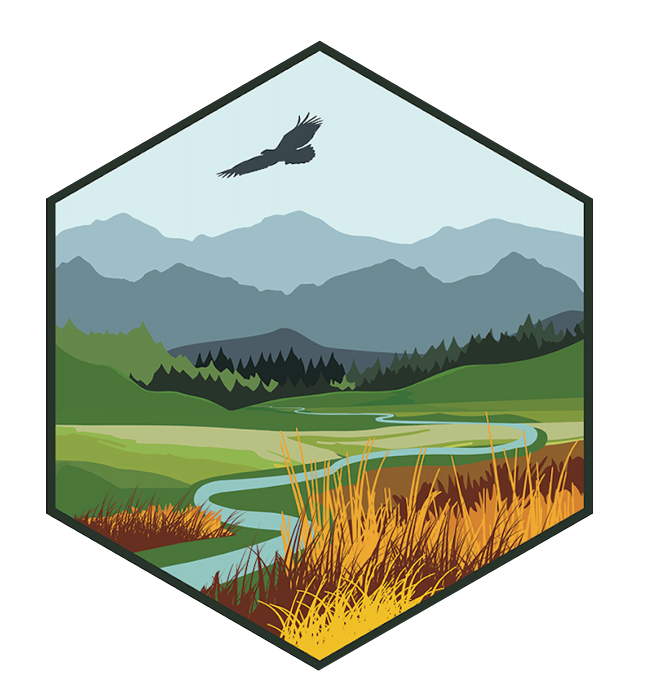The Social Side of Sagebrush
Date
The Social Side of Sagebrush
by Lauren Barrett
How can we promote human well-being by better understanding the connections between social and ecological systems? What new challenges and opportunities does climate change create for managing such interdependent social and ecological systems? These questions were pondered when, on two hot days in late August of 2024, the North Central Climate Adaptation Science Center welcomed 27 experts to the University of Colorado Boulder’s campus to participate in a workshop on the rapid transformations occurring across much of the sagebrush biome – the largest contiguous ecosystem type in the continental United States. Collectively, sagebrush ecosystems are often fondly referred to as the “Sagebrush Sea” for the sweeping views of abundant blue-green sagebrush plants and the wide-open skies that characterize these widespread landscapes in the western US. Beyond the iconic sagebrush plant, these ecosystems are home to a diverse array of native shrubs, grasses, and flowering plants that support a large number of wildlife species, including the greater sage-grouse, mule deer, and pronghorn antelope.
Despite increased investments in sagebrush conservation by government agencies, research institutions, and NGOs over the past two decades, the fragile ecosystem has lost 50% of its historic range to invasive grasses, conifer encroachment, wildfire, suburban sprawl, energy development, and overgrazing. Such ecosystem loss and degradation is not only devastating for biodiversity, but also for the many communities that rely on the vital ecosystem services that sagebrush provides. These services include livestock grazing, recreation, climate stabilization through carbon sequestration, water and nutrient cycle regulation. Sagebrush ecosystems are also an important part of regional culture and identity.
Gathered in a large semi-circle in CU’s Sustainability, Energy and Environment Community building, sagebrush experts shared their knowledge and experiences with sagebrush conservation and management. Focused on the eastern sagebrush biome in Colorado, Montana, and Wyoming, the experts discussed current management challenges, the available resources and tools used by stakeholders, and uncertainties that still exist in understanding how to manage for and respond to drivers of change in sagebrush, particularly within the context of a changing climate. While many experts spoke in their capacity as federal agency employees – from the Bureau of Land Management, U.S. Geological Survey, and U.S. Fish and Wildlife Services – others came from research institutions, Tribal nations, and the NC CASC’s “Transformations in Sagebrush” Rapid Climate Assessment Program (RCAP) team.
As part of NC CASC’s RCAP, I worked as a summer graduate research assistant to identify the sociocultural context for sagebrush in the North Central ecoregion: the competing land uses, the primary stakeholders and right holders, and the information needs of resource managers working in sagebrush. Sagebrush is home to rural and Tribal communities, and many urban residents also spend time in sagebrush ecosystems through recreational activities. These communities both shape and are shaped by sagebrush ecosystems, making them essential participants in any land management and conservation strategy concerned with both human and ecosystem health. The region is bustling with activity. Primary land uses include energy development (oil and gas development, coal and mineral mining, geothermal development, and solar/wind farms), urban development, livestock grazing, and recreation like hiking, biking, hunting, and fishing.
I presented these findings from my synthesis to the sagebrush experts in August. While there has been a proliferation of natural scientific studies on ecosystem transformation, drivers of change, and the influence of climate change on said drivers (please see this blog by Katie Bardsley for more) there has been considerably less research on the sociocultural dimensions of transformation in the sagebrush biome. I found three broad areas in need of more attention, as detailed below.
Understanding and Integrating Local Knowledge and Values:
A deeper understanding of local knowledge and how sagebrush is valued in different areas would help resource managers engage with communities and monitor ecosystem changes on the very local level. Historically, the knowledge held by Tribal communities has been systematically discounted and suppressed by state and federal governments. There has been a more recent shift to acknowledge the Traditional Ecological Knowledge (TEK) held by Tribal nations, but partnering with Tribal nations will require more conscious work and listening by agencies to understand how to transparently and ethically build collaborations.
Other communities, such as recreationalists, are often presented in the sagebrush literature as drivers of sagebrush degradation, but there is little understanding of how recreation may affect conservation values or influence local understandings of sagebrush ecosystems. Overall, more attention to the diverse cultures and histories that shape stakeholder interactions with sagebrush ecosystems has the potential to not only aid engagement efforts, but could enhance our scientific understanding of sagebrush ecosystems and how they are interrelated with human health and well-being.
Changes in Rural Economies and National Priorities:
Many rural communities are experiencing considerable change through population loss, population growth and demographic change, and/or shifting economic drivers. For example, family-owned ranches are struggling to compete with concentrated feed lots, increasing land prices, uncertain succession pathways, and increasingly long and dry wildfire seasons due to climate change. If ranching in many rural areas is declining, what land uses are replacing grazing on both private and public lands? How might this shift rural values, economies, and livelihoods? How might these shifts impact already vulnerable rural communities and their relationship with the land?
Similarly, major changes are occurring on the national stage. The Biden administration has set lofty economy-wide decarbonization goals, which require a considerable buildout of renewable energy sources on public and private lands. More research into the tension between climate mitigation strategies and conservation goals is needed to minimize harm to both sagebrush and neighboring communities.
Building the Capacity, Networks, and Expertise to Incorporate Justice Frameworks
Recent initiatives passed by the Biden administration, such as the Justice40 executive order (EO 14008), in combination with decades of hard work by environmental justice (EJ) advocates, require federal agencies to consider EJ in land management and conservation decisions. Environmental justice is the fair treatment of all people, regardless of race, color, national origin, income, disability, or Tribal affiliation, in the development, implementation, and enforcement of environmental laws, regulations, and policies. Historically, federal and state agencies have been successful at gathering natural science information and expertise, but less attentive to the justice concerns of conservation and management actions. This moment presents a strategic opportunity to (re)assess what bureaucratic processes, agency expertise, and local/agency networks are needed to better integrate EJ frameworks into the everyday work of agency personnel.
Concluding Thoughts:
As the workshop came to a close on the second day of presentations and lively discussions, the social dimensions of sagebrush transformation emerged alongside more traditionally ecological research questions in the list of priority research topics compiled by participants. An outcome that warms the heart of this cultural anthropologist, and represents a small but noteworthy step in the NC CASC’s important work in understanding the sociocultural context of ecological systems.
About the Author: Lauren Barrett is a PhD Candidate in the department of anthropology at CU Boulder. Her dissertation research examines residential electrification efforts in Colorado, and explores how transitioning away from fossil fuels in our homes can be done in just and equitable ways. She was thrilled to join the Sagebrush Rapid Climate Assessment Team this summer to learn more about the intersection of land conservation/management and social science.


